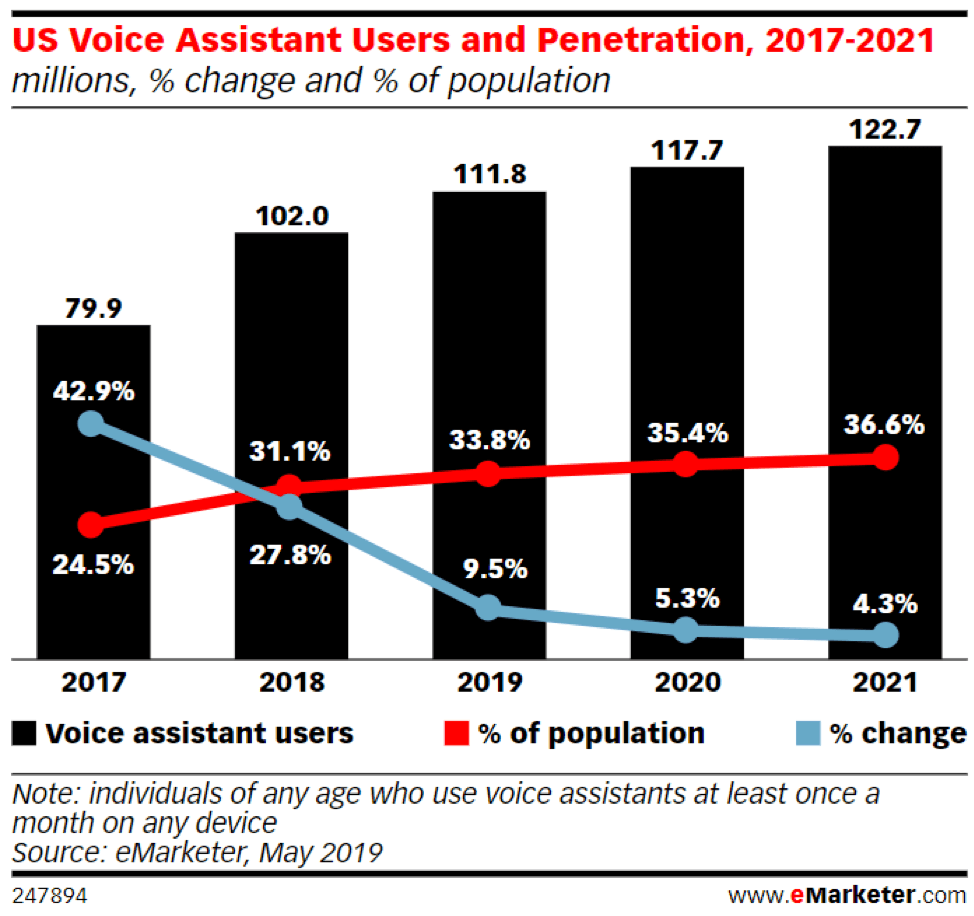As voice search continues to grow in popularity, follow these tips to ensure you rank higher for important, relevant voice search queries.
By 2020, there will be 200 billion voice search queries per month and more than half of searches will come from voice and image search, according to Econsultancy’s reports.
As of August 2019, reported statistics show that about 41% of adults use voice search at least once per day.
eMarketer has gone as far to predict that over one-third of the US population will use some form of voice search monthly in 2019, up almost 10 percent from 2018.

There’s no doubt that as the technology behind voice search improves and is adopted by more consumers, it’ll be one of the primary ways of finding information online.
Voice search has been around for years, slowly evolving to where it is today to become more commonly used through devices like Alexa, Google Home, Siri and others.
The substantial growth of voice search queries will mean that businesses are going to need to optimize their offerings for the intricacies of these types of searches.
These optimizations, for now, only need to be minor as existing SEO best practices will already help prepare your business.
This former Burger King commercial that triggered a search of the Whopper on Google Home was a clever stunt that generated tons of media coverage, but isn’t the right way to drive attention for your business with voice search.
To get ahead of the curve and rank for relevant queries in the future, here’s how to start adapting your SEO strategy now to account for voice search across platforms.
Most Common Use Cases (To Date)
When considering what changes to make, start by understanding the three types of businesses that are going to see the biggest impact from voice search:
- Local brick-and-mortar businesses (restaurants, automotive shops, dry cleaners, etc.)
- E-commerce retailers (Amazon, Walmart, Nordstrom, Williams-Sonoma, etc.)
- Media sites (Wikihow, Mashable, CNN, The Guardian, USA Today, etc.)
“All three of these business types lend themselves to quick answer types of searches,” says Dominique Jackson, an SEO specialist at Sprout Social, blogger, and a freelance content marketer.
“Meaning, people are doing a voice search for a very specific answer, without a need for a lot of additional context.”
For example, you might ask, “Can I wash a cashmere sweater in the washer?” to get a simple answer rather than asking, “How do I knit a sweater?”

For the latter search, people are likely to manually type in the search on Google or YouTube because they want in-depth information on how to perform a task or learn more about a complex subject.
Voice search could, however, lead to a more shallow dive into your brand. Because searches are not necessarily looking a deep-dive search of an answer, voice search if done correctly should suffice. An example, if two friends are arguing about when the Breakfast Club was released, one of them may just ask their phone, “What year did the Breakfast Club come out?”
Siri or Google will then probably answer something along the lines of, “the Breakfast Club was released in 1985.” Settling the debate. But the point being, the two friends aren’t diving deep into curiosity of the film such as cast, director or other info. They want a simple answer to one question that will settle their debate.
But for voice search, it’s all about quick results for a simple question, according to Jackson. “So, in order for businesses to start preparing, they need to think of what type of questions people in their industry ask, that don’t require a super in-depth answer.”
“For a brick-and-mortar business, it could be appealing to questions about store hours or location,” says Jackson.
Think of the quick questions a person might want to know about your local business while researching or prior to visiting your location.
The types of questions you’re optimizing for voice search will vary based on your industry, type of business, and the audience you’re trying to reach.
“For online retailers, it could mean making sure your products are properly organized for people looking for a quick order, or even reordering something they’ve purchased from you before,” adds Jackson.
“I don’t believe we’re that far away from a world where voice search will be able to place orders for consumers. Something like, ‘Show me blue jeans / Show me size 12 / Order me the pair from American Eagle,’” says Aaron Agius, the managing director and founder of Louder.Online.
“In these types of queries, brand recognition becomes more important to the conversion,” says Agius. “That’s something that forward-looking e-commerce sellers should be thinking about now.”
And for a media company, it might mean making sure articles on certain subjects are prepared to answer quick questions on a topic. This approach is important to all three types of businesses affected by voice search, but particularly the media.
For example, an article called “Remedies for Soothing a Sore Throat at Home” might be 1,000 words but provide one answer to the question succinctly in the first paragraph with a sub-header that says: “How to Soothe a Sore Throat.”
This way the article provides a quick answer for voice search, while also providing additional details for someone who’s reading the piece for more in-depth information.
Consider which of the primary business use cases is right for your organization before optimizing.
Study Customer Intent
With the right use case in mind, you’ll have an understanding of the intent of your audience, whether they’re reading your articles, shopping online or planning to visit your store.
The intent of your customers (the reason behind their search) is what should direct all of your optimizations, especially when creating content for your website.
For SEO purposes you should already be creating informative content to help and support your audience, but for voice search, focus more heavily on covering long-tail subject matter.
Long-tail keywords are very specific searches that include multiple words or phrases like “vegan restaurants in Kew Gardens” or “men’s wallet with a coin compartment.” Because these keywords are very specific, the competition to rank for them is much lower.
The headline and focus of some of your content should be very specific, but that doesn’t necessarily mean it needs to be particularly in-depth for the purposes of voice search.
When consumers are searching on their phone, Alexa or another device they typically ask very specific questions and want simple answers.
The goal is to answer these questions with written content focused on long-tail topics as a part of a greater mix of content included on your company’s website.
Beyond brainstorming a list of questions your customers might ask, use these tools to learn a range of question suggestions based on user search data:
As your organization develops this content, address the questions you think your audience is asking as they relate to your offerings.
Add Schema Markup
Another way to signal to the search engines what your website is about, especially for voice search queries, is with schema markup.
Similar to rich snippets, schema markup is code added to your website that provides context to the search engines as to what different text included means.

For example, if you created a page about the children’s movie Bolt, you’d include markup to let the search engines know this is a movie, not a page about a metal pin or BoltBus.
According to Kissmetrics, there is data markup for:
- Articles
- Local businesses
- Restaurants
- TV episodes and ratings
- Book reviews
- Movies
- Software applications
- Events
- Products
“The nice thing about optimizing for voice search, at least in its earliest iterations, is that most of the queries the engines will be responding to will be conversational in nature. Think of questions like, ‘Ok Google, what’s the average temperature in Puerto Vallarta in May?’” says Aaron Agius.
“Optimizing for those queries comes down to using schema markup appropriately and building content that answers these and other questions search users might have — which you should already be doing, post-Hummingbird.”
To add schema markup to your website, follow this guide by Schema.org and then test it to ensure it’s working by using Google’s Structured Data Testing Tool.
Reviews for Local Business
For local companies, online reviews have always been an indicator if people will visit your store or if you’ll show up in a search for your type of business.
Similarly, voice search queries will likely be impacted by the number and range of quality reviews your business has accumulated.
When someone searches, “a hardware store near me” or “an Ethiopian restaurant in South Philly,” the reviews your business has compared to your competitors in your specific niche will likely be considered when an answer is provided.

To spur more quality reviews for your local business, encourage customers to leave reviews if they’ve enjoyed their experience and continually offer high-quality customer service.
From a customer service perspective, your company should not only deliver valuable experiences in person, but also online by responding to reviews left about your business.
Negative reviews can damage your reputation, which is why it is important to respond publicly wherever the review is posted and apologize, then remedy the situation as soon as possible.
Be Comprehensive
Complete all the local business listings for your company’s physical locations, whether you’re a mom-and-pop store or a large enterprise business with multiple retail stores.
Ensure each listing of your business is accurate and complete across Google, Yelp, Bing, Apple Maps and other relevant services.
A voice search is likely referencing the information listed on these profiles to understand store hours, directions, menu options and more.
Fill out these listings for your business manually with each service or by using a tool like Moz Local, Yext or ReachLocal to complete your listings across multiple locations at once.
Get Mobile Friendly
A must-have for visibility online today is ensuring your web properties are mobile friendly to account for how consumers find information and how the search engines rank your website.
This is also likely a major consideration for voice search too as a mobile friendly website clearly illustrates the relevant information people are looking for in the right format.
Focusing on the user experience provided to your customer base on mobile will only help your business better deliver value and clearly explain your product and service offerings.
Here are the primary ways to make your website more mobile friendly:
- Continue to invest in traditional on-page and off-page SEO tactics like adding proper metadata and building quality links to your website.
- Design your website as responsive.
- Address any structural mobile errors that Google identifies with the Mobile Friendly Testing Tool.
- Add long-tail keywords naturally across your website and as a focus of your content.
- Ensure information is easy to find on your website and that your webpages load quickly.
- Review our mobile SEO starter guide for more in-depth tips for mobile optimizations.
Understand that voice search results differ from what you’re served in the Google search box, impacting how you approach this new, and developing search opportunity.
Looking for More Help?
With the growing usage of voice search queries, it’s important to keep your head in the game. If you want the expertise of an SEO agency on voice search or other marketing tactics, give us a shout.

